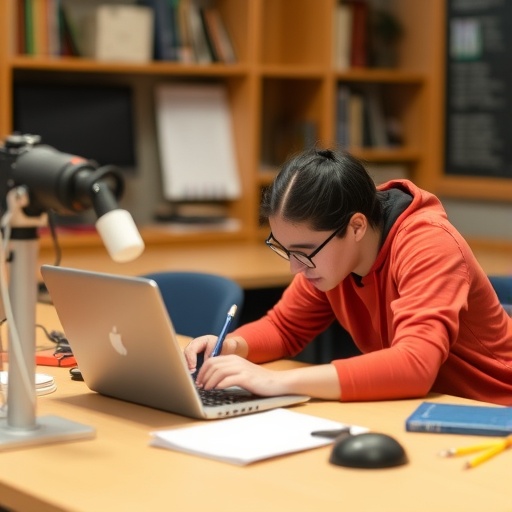In the rapidly evolving landscape of education, the integration of technology has transformed traditional paradigms, particularly in programming education. The article titled “Transforming Programming Education: A Comparative Study of Traditional and Tech-Enhanced Online Learning for Undergraduates and Graduates” by Fodouop Kouam, published in 2025, presents a thorough exploration into how students engage with programming through different learning methodologies. This comparative study sheds light on the effectiveness of traditional versus tech-enhanced online learning environments, providing invaluable insights that could reshape educational practices.
Programming, often considered a complex subject, requires not only a solid understanding of theoretical constructs but also practical skills that can be developed over time. The advent of digital technologies has opened up new avenues for teaching and learning, allowing educators to reach students in innovative ways. However, the challenge lies in determining the effectiveness of these varied approaches in fostering both understanding and skill acquisition among students. This study critically evaluates these two different learning environments to understand their impact on student learning outcomes.
Traditionally, programming education has relied heavily on in-person instruction, where students would engage with instructors and peers directly. This approach fosters interpersonal communication and immediate feedback, which are vital for debugging code and collaborative problem-solving. The face-to-face interaction can enhance motivation and accountability among students, leading to a more engaged learning atmosphere. Nevertheless, traditional methods often come with limitations, especially regarding accessibility and flexibility.
Tech-enhanced online learning, on the other hand, offers a modern alternative that transcends geographical boundaries. By utilizing platforms that facilitate video lectures, interactive coding exercises, and peer collaboration via forums, students can learn at their own pace and revisit complex concepts as needed. This learning environment accommodates diverse learning styles and can be particularly beneficial for those who may struggle in a conventional classroom setting. However, it also requires a level of self-discipline that can be challenging for some students.
Kouam’s research aims to discern the nuances between these two educational frameworks, focusing on how they cater to undergraduates and graduates in programming disciplines. Examining a cross-section of students from both environments, the study utilizes quantitative and qualitative analyses to uncover the strengths and weaknesses inherent in each mode of education. Through surveys and performance metrics, Kouam’s study illustrates the differing levels of engagement, comprehension, and retention of knowledge among students enrolled in both formats.
One of the pivotal findings of the research is that tech-enhanced online learning can indeed match, if not surpass, the effectiveness of traditional methods in certain areas. For example, students in online environments demonstrated a significant improvement in their coding skills, thanks in large part to the vast array of resources available at their fingertips. Access to interactive coding platforms and online forums allows for real-time practice and support, which can replicate some aspects of the communal learning found in traditional classrooms.
Moreover, the flexibility afforded by technology allows students to create personalized learning journeys. Students can choose when to study, how to approach difficult topics, and which resources best suit their learning needs. This autonomy often leads to greater satisfaction with the learning process. However, the study also notes a crucial downside: the potential for distractions in online environments. Without the structure of a classroom, students may struggle with time management and focus, ultimately hindering their learning experience.
Despite the differences, Kouam’s study emphasizes that the most effective programming education may arise from a blended approach that combines the strengths of both traditional and online learning. By integrating the social aspects of in-person interaction with the flexibility and resources of online education, institutions can create a more holistic learning environment. This perspective is especially relevant in the post-pandemic landscape, where many educational institutions have had to adapt rapidly to digital learning.
Larger implications of the research extend beyond programming education, suggesting that similar studies could be conducted across various disciplines to evaluate how technological advancements are reshaping learning. As education continues to evolve, insights from this research can guide educators and policymakers in developing curriculum frameworks that are more aligned with the needs of contemporary learners. By understanding the unique contributions of both traditional and tech-enhanced approaches, educators can better equip students to thrive in an increasingly digital world.
Furthermore, the study highlights the role of instructor presence in tech-enhanced learning environments. Engaging educators who provide timely feedback and guidance can significantly enhance the online learning experience. The study points out that the mere presence of instructors in online settings can increase student motivation and satisfaction, ultimately influencing their overall performance. As such, training educators to excel in online pedagogies is crucial to maximizing the benefits of tech-enhanced learning.
In conclusion, Fodouop Kouam’s comparative study not only reveals important findings about the transformative potential of technology in programming education but also invites further exploration into how such methods can adapt to various educational contexts. As educational institutions continue to navigate the intricacies of incorporating technology into their curricula, this research serves as a foundational reference for improving teaching methodologies and enhancing student outcomes in programming and beyond. The evolution of education is a collective journey, and studies like Kouam’s illuminate the path forward towards a more equitable and effective learning landscape.
Subject of Research: Comparative study of traditional and tech-enhanced online learning in programming education.
Article Title: Transforming programming education: a comparative study of traditional and tech-enhanced online learning for undergraduates and graduates.
Article References:
Fodouop Kouam, A. Transforming programming education: a comparative study of traditional and tech-enhanced online learning for undergraduates and graduates. Discov Educ (2025). https://doi.org/10.1007/s44217-025-00981-x
Image Credits: AI Generated
DOI: 10.1007/s44217-025-00981-x
Keywords: programming education, online learning, traditional learning, educational technology, student engagement.




